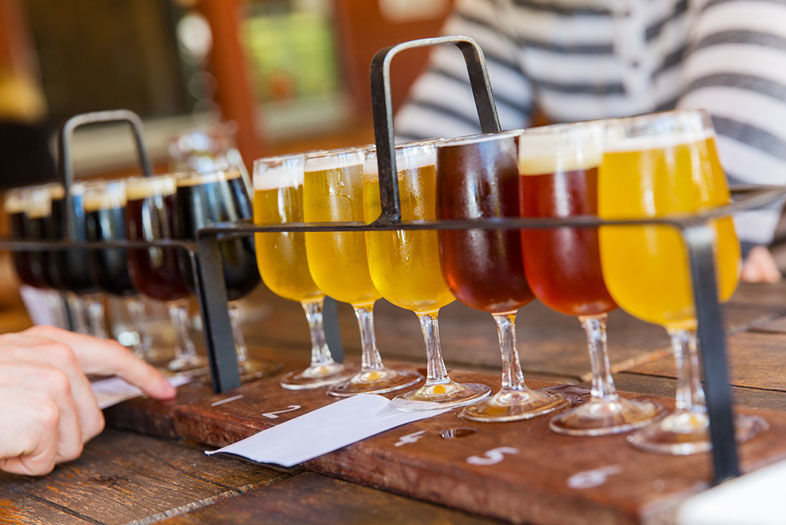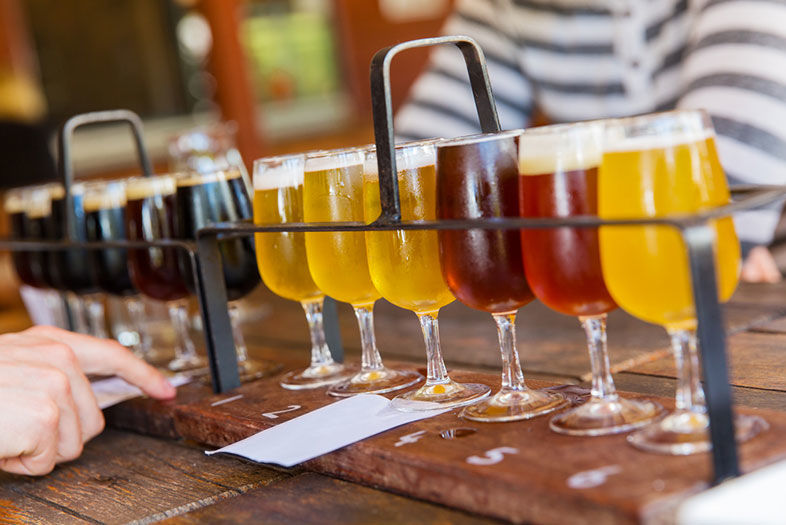People have been swirling, sniffing, and sipping the wine in their glasses for centuries. These rituals, if performed by pompous ninnies with overblown egos, can seem like ridiculous affectations. But, despite the potential for abuse, the motivation to taste well-crafted beverages with intention—to pay attention—is a good one.
A few decades ago, the very idea of swirling, sniffing, or sipping a mass-produced beer would have been ludicrous and laughable; in fact, simply pouring your beer from a can into a glass would have likely been seen as a brazen act of buffoonery. And then craft beer came back onto the scene. For the first time in a long time, beer was being made with serious aspirations to quality; fresh ingredients hand-made in small batches with the goal of creating complex flavors. Once this kind of beer became available, the idea of tasting it and evaluating it seriously became not only possible, it became necessary.
Let me pause here for a moment. I don’t mean to imply that tasting beer “seriously” or with “intention” is any kind of requirement or expectation. You may have no desire to pay attention to what you drink—there’s nothing wrong with that—and you may be perfectly happy to find one or two beers you know you like and just stick with those. No judgment. But, if you’re interested in exploring new styles, experiencing new flavors, and expanding your palate, it’s helpful to have a basic framework within which to work.
If you’re out tasting beer with any sort of regularity, you’re likely encountering a wide range of flavors; from sweet, roasty, malty flavors that include coffee, caramel, and chocolate, to bitter beers built with citrus, pine, and tropical fruit components, to crisp, fruity, and spicy beers with pronounced biscuit-like aromas. In some instances, you may also be encountering flavors you don’t like very much at all. Some of those flavors may be perfectly appropriate and intentional for the style, but some of them may also be actual defects. Just as it’s useful to have a vocabulary for identifying the “good” flavors you like, it’s also useful to have a vocabulary for describing the nasty bits. [All that being said, it’s also valuable to note that one person’s defect may be another person’s flavor fave. No two people experience flavors the exact same way.]
Here’s a basic overview of some of the most common flavor components you’ll find in craft beers, along with some of the most common defects you’re likely to encounter. It’s advisable to have a general idea of the acceptable flavors to be found in various styles as they vary widely and—yes, more gray area—what’s acceptable in one style can be unacceptable in another.
Beer Styles
For simplicity’s sake, let’s break down all beer styles into four basic categories: the malty beers, the bitter beers, the spicy beers, and the sours.
Malty Beers: This category generally includes, in ascending maltiness, Pilseners, Kolsches, Blondes, certain Reds and Ambers, ESBs, Marzens, browns, Dopplebocks, Barley Wines, Wee Heavys and Scottish ales, Belgian Dubbels and Quads, Stouts, and Porters. The typically “good” aromas and flavors include: roasted coffee, bitter chocolate, toffee, vanilla, and caramel. Belgian styles will also typically have a “fruity ester” component in the aroma, which is often described as “banana-like,” “biscuit-like,” “pear-like,” even “rose-like.”
Bitter Beers: This category includes the more hop-centric styles, such as California Commons, hoppy Reds and Ambers, Pale Ales, IPAs, double IPAs, and imperial IPAs. The typically “good” aromas and flavors include citrus, pine, freshly cut grass, tropical fruit, pineapple, and floral and herbal notes.
Spicy Beers: While these beers are not “spicy” in a chili pepper kind of way, warm fermentations with specific strains of yeast give these styles more “bite” for backbone, in addition to an often more pronounced fruity character. Typically low to medium on the hop scale, these styles include wheat beers/Witbiers, Hefeweizens, Belgian Blondes, Saisons, and Belgian Golden Strong Ales.
Brettanomyces Beers and Sours: Here’s a category where, basically, all bets are off. The flavors and aromas to be found in this very widely defined category can be all over the map—mostly because these beers are often the result of random variables that cannot always be predicted or reproduced with great consistency. The mysterious and “wild” nature of these beers is a large part of their allure for many craft fans. For Brett beers, aromas and flavors often range to the “funky,” and are typically described as “horsey,” “goaty,” “leathery,” “wet blanket,” and “phenolic” (like band-aids). Sours may share some of these characteristics, but will also be generally tart and highly acidic. Sours and Brett beers can be produced in almost any style, from light, crisp, and highly carbonated, to deep, rich, malty, and barrel aged.
Off Flavors
So, that’s a lexicon for the aromas and flavors a brewer wants you to find in his or her beer. Now let’s go over some of the most commonly found beer bummers—the off flavors and aromas that can mask or ruin the best things a beer has to offer. I’ll list the negatives in regular layman’s terms, but I’ll also provide a sound byte by way of explanation (for the science lovers). You may not know what to call them, but here are some things that you don’t want to find in your pint glass:
“Buttered popcorn”: Also known as “diacetyl” character. Although this aroma and flavor is desirable in very small amounts for some Scotch Ales, stouts, and other styles, it is highly undesirable in most other beers. Often caused by incomplete fermentation, poor yeast health, or fermentation at a too low temperature.
“Green Apples/Vinegar”: In the vast majority of beers, this aroma and character is undesirable (in certain American lagers it is acceptable in low levels). Often caused by premature removal of yeast during fermentation, bacterial spoilage, or exposure to oxygen.
“Wet Cardboard”: Here’s an easy one: no beer should taste like wet paper, cardboard, or stale bread crumbs. Caused mostly by problems related to age and oxidation.
“Cooked Corn“: Also commonly described as “cabbage” or “parsnips,” this aroma or flavor should not be present in any beer (except in low levels in American lagers). Often caused by poor sanitation or yeast contamination.
“Band-Aids”: Also commonly described as “clove-like” or “plastic,” this problem is caused by phenols. Here’s one where some levels are actually appropriate in certain styles, such as some Belgians, some smoked beers, and some wheat beers. But if you’re getting these components in a Pale Ale, an IPA, or even a Stout, you’ve got a defective beverage. Often caused by poor sanitation, poor water filtration, or impure yeast strains.
“Rotten Eggs”: Familiar to many as “sulpher” or “struck match,” this is a component you don’t want in any beer, no matter what the style. Often caused by contamination or poor sanitation.
“Mouth-puckering”: A well-made beer should not be astringent; it should not cause an unpleasant “drying” sensation in your mouth, reminiscent of biting into the outer skin of wine grapes. Often caused by overheating mash (grain/water) mixture or over hopping.
These are what I have found to be some of the most common defects in beer. Unfortunately, there are others; fortunately, the others are not as common. No matter what you call them—good or bad—you’ll expand your knowledge (and, dare I say, enjoyment?) of craft beer by taking the time to simply focus your attention on what you’re seeing, smelling, and tasting. Think of it as “Beer Mindfulness.” That way, you can go out, enjoy a few pints, and have the double satisfaction of knowing that you’re not only improving your palate, you’re also improving yourself. (I love it when self-improvement and beer go together!)

PARTNER CONTENT
Beer Mindfulness: Do You Have Good Taste?

















